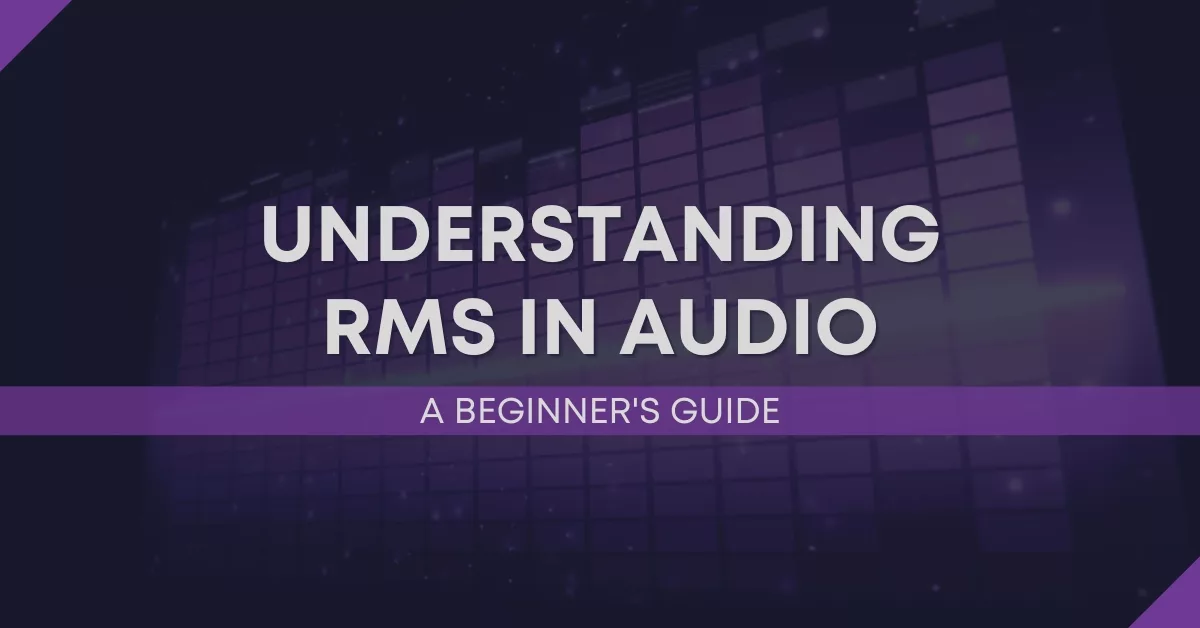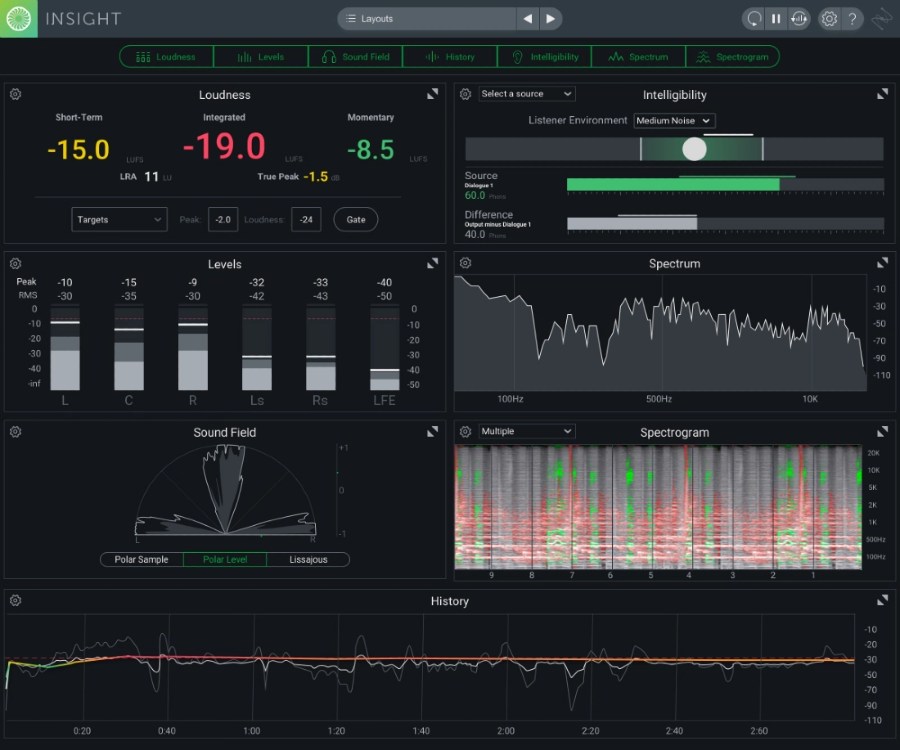
When it comes to audio, the term "RMS" is often thrown around, but what exactly does it mean? RMS stands for "Root Mean Square" and is a measurement of the average power of an audio signal over time. Understanding RMS is important for anyone who works with audio, from musicians and audio engineers to podcasters and content creators.
In this beginner's guide, we'll explain what RMS is, how it's calculated, and why it matters in audio. By the end of this post, you'll have a solid understanding of RMS and be better equipped to use it in your audio projects. But, before we can get into RMS, we must first discuss what loudness is.

Loudness is a subjective sensation that is influenced by many factors, including the sound pressure level, frequency response, and dynamics of an audio signal. An individuals difference in hearing sensitivity and preference must also be taken into account. Understanding how we perceive loudness in audio is important for creating content that is appealing and engaging to listeners.
The human ear is sensitive to a wide range of sound pressure levels, from the faintest whisper to the loudest explosion. However, our perception of loudness is not linearly related to sound pressure level. Instead, our perception of loudness is influenced by a number of non-linear factors, such as frequency response, temporal dynamics, and contextual factors.
One important factor in loudness perception is the frequency response of a sound. The human ear is more sensitive to sounds in the midrange frequencies (around 1-4 kHz), which are most important for speech and music perception. Sounds in the low and high frequency ranges require stronger sound pressure levels to be perceived as equally loud as sounds in the midrange.
Temporal dynamics also play a role in loudness perception. Our ears are sensitive to changes in sound pressure level over time. They can perceive a sudden increase or decrease in sound level as being louder than a steady state sound at the same level.
Contextual factors can also influence loudness perception. For example, a sound that is played in a quiet environment may sound louder than the same sound played in a noisy environment. Similarly, a sound that is played after a period of silence may sound louder than the same sound played after a period of continuous sound.
In audio production, it is important to consider these factors when creating and finalizing content. For example, by boosting the levels of frequencies that are most important for speech and music perception, producers can create content that is perceived as being louder and more engaging. Similarly, by using dynamic processing tools like compression and limiting, producers can control the temporal dynamics of a signal to create a more consistent and impactful listening experience.
RMS stands for "Root Mean Square". In audio, RMS is a measurement of how much continuous power an audio signal produces. This means that RMS tells us how loud sound is on average over time, taking into account the dynamic range of the signal.
To calculate the full RMS power level of an audio signal, you first need to square each sample of the signal, then take the mean of those squared values, and finally take the square root of that mean value. This process yields a single RMS value that represents the overall loudness of the signal.
Check out this FREE online RMS level calculator CLICK HERE.

RMS is an important metric in audio engineering because it can tell us a lot about the dynamic range of a signal. Dynamic range refers to the difference between the loudest and quietest parts of a sing. A signal with a high RMS value has a high average loudness, which suggests that it has a wide dynamic range. Conversely, a signal with a low RMS value has a low average loudness, which suggests that it has a narrow dynamic range.
Knowing the RMS of an audio signal can be useful in a variety of situations. For example, when mastering an album, the mastering engineer will often use RMS to ensure that all of the tracks have a consistent overall loudness. By adjusting the RMS of each track, the engineer can make sure that they all sound equally loud when played back-to-back.
RMS can also be useful in live sound reinforcement. In a concert setting, the sound engineer may use RMS to ensure that the overall volume level of the mix is consistent throughout the performance. By monitoring the both peak and RMS values of a mix and adjusting the levels of individual instruments as needed, the engineer can create a balanced and cohesive sound.
When it comes to loudness measurement units, RMS is not the only one. There are several other ways to measure loudness in the world of audio production. Here are 3 of the most popular loudness units referenced today.

Peak measurement in audio refers to the process of measuring the highest instantaneous level of an audio signal, or the point at which the waveform reaches its maximum amplitude. Peak measurement is typically expressed in decibels (dB) relative to a specific reference level. This level is typically 0 dBFS (decibels relative to full scale), which is the maximum level that can be represented in a digital audio system.
Peak measurement is an important consideration in many areas of audio production, including recording, mixing, and mastering. When an audio signal exceeds its maximum level, it can result in distortion, clipping, or other unwanted artifacts that can negatively affect the quality of the audio. By measuring peak level, producers and engineers can ensure that the peak volume of the signal remains within safe and desirable levels.
In digital audio systems, peak measurement is typically performed using a peak meter, which displays the maximum level of a signal over a specific period of time. Peak meters can be configured to display the maximum level of a single channel or the maximum level of multiple channels in a stereo or surround sound system. By measuring both peak levels and RMS levels, engineers can ensure that the audio isn't clipping while also providing the desired level of dynamic range and impact.
LUFS (Loudness Units Full Scale) is a measurement of loudness in audio that takes into account the frequency response and dynamics of the human ear. It is a standardized measurement that provides a more accurate representation of the perceived loudness of audio content than traditional peak and RMS measurements.
LUFS is used to measure the loudness of audio content in a way that is consistent across different platforms and playback devices. This is important for ensuring that audio content is perceived in a consistent way by listeners, regardless of how and where it is played back.
LUFS measurements are typically made using specialized software or plugins that analyze the audio content and provide a numerical value representing its loudness in LUFS. The measurement process takes into account the entire audio signal, rather than just the highest or average level, and provides a more accurate representation of how the audio will be perceived by listeners.
LUFS measurements are commonly used in broadcast, streaming, and other audio delivery formats to ensure that audio content meets specific loudness standards. For example, many countries and organizations have established specific loudness standards for broadcast audio, such as the ATSC A/85 and EBU R128 standards, which specify target loudness levels in LUFS.
FACT: In the modern music production world, LUFS is the most important measurement in audio mastering.
One of the most commonly used loudness measurement units in audio is decibels relative to full scale (dBFS). This unit measures the level of an audio signal relative to the maximum digital level, which is 0 dBFS. This means that a signal that is at its maximum level will read as 0 dBFS, while a signal that is quieter than the maximum level will have a negative dBFS reading.
While dBFS is a useful unit for measuring the level of digital audio signals, it doesn't take into account the subjective loudness of the signal. This means that two signals with the same dBFS reading may sound different in terms of their perceived loudness.

Loudness, sound field, intelligibility, spectrum, and spectrogram meters providing advanced data for your mixes and masters.

Accurate loudness metering, measurements, correction and adjustment tools for music production, broadcast, games, and more.
In conclusion, understanding RMS is essential for anyone working with audio. Whether you're mixing music, producing podcasts, or creating video content, understanding RMS can help ensure that your audio sounds its best. By knowing how to measure and interpret RMS values, you can optimize your audio levels and avoid inconsistencies.
We hope this beginner's guide has been helpful in demystifying RMS and giving you the tools you need to use it effectively in your audio projects. With a little practice, you'll be an RMS expert in no time.
"Some of the links within this article are affiliate links. These links are from various companies such as Amazon. This means if you click on any of these links and purchase the item or service, I will receive an affiliate commission. This is at no cost to you and the money gets invested back into Audio Sorcerer LLC."